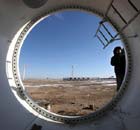Companies
Tibet Airlines to launch in May
By Chen Jialu (China Daily)
Updated: 2010-04-20 10:47
 |
Large Medium Small |
China prepares to launch its first airline based in southwestern Tibet - Tibet Airlines Co Ltd next month.
Tibet Airlines, with a registered capital of 280 million yuan, will be headquartered at Konggar Airport in Tibet's capital, Lhasa, and will provide domestic cargo and passenger services, said Cheng Hui, head of the preparatory team for Tibet Airlines.
The company will have 20 aircraft within the first five years of operation and the airlines fleet will expand in line with demand, said Cheng.
All the planes used will be modified to adapt to the plateau environment, and flights will begin in mid 2011. Cheng added that most employees will be recruited locally.
Focus will begin on establishing flights within Tibet and operations will gradually expand to offer flights to other provincial capitals.
Currently, six domestic airlines operate in Tibet with a total of 16 flight routes.
State-owned Tibet Investment Co Ltd will own a 51 percent stake in the company while the remainder will be held by two Lhasa-based investment companies- Sanli and Ruiyi.
Tibet Airlines was approved by the General Administration of Civil Aviation in March, amid robust growth in Tibet tourism.
At present, Air China has a 50 percent share of Tibet's aviation market. According to central government plans, there will be five airports in Tibet by 2011.
Bolstered by its burgeoning tourism, the gross domestic product of Tibet reached 43.7 billion yuan last year, a two-digit increase compared with that of last year.
The autonomous region received 5.56 million tourists last year, a year-on-year increase of 30 percent.
The booming tourism is a golden opportunity for the development of the aviation industry in the region.
However, experts said a careful flight strategy should be mapped out first as the region's tourism is under the influence of seasonal change and cost of operations in Tibet is much higher than places with lower altitude.
Xinhua contributed to the story









